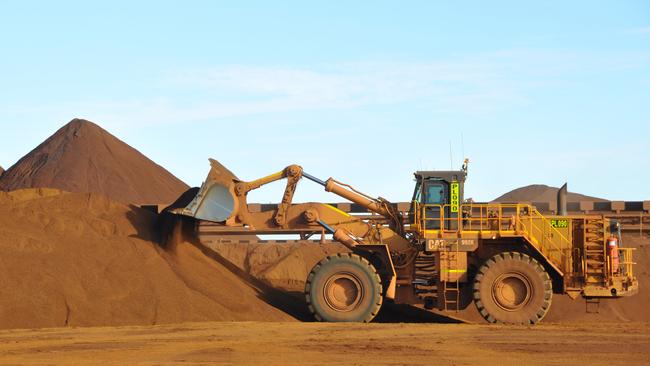Fortescue Metals’ Iron Bridge project hit by cost blowouts
Fortescue Metals is facing the prospect of a major budget blowout at its Iron Bridge magnetite project in Western Australia.

Fortescue Metals is facing the prospect of a major blowout at its Iron Bridge magnetite project in Western Australia, as escalating costs threaten the project’s $US2.6bn ($3.4bn) budget.
Industry sources suggest Fortescue is revising the budget on the project and could be forced to revise its cost upwards by as much 25 per cent as it faces blowouts on building non-processing and pipeline infrastructure, as well as the massive processing plant and mine.
At worst, that could equate to a budget increase of as much $US650m, although it is understood no revised budget has yet been agreed between Fortescue and its project partner, Taiwan’s Formosa Plastics, which has a 31 per cent stake in the project.
Iron Bridge includes an ore processing facility capable of producing 22 million tonnes of concentrate a year, an airstrip and accommodation camp, as well as a 135km pipeline to Port Hedland to pump magnetite slurry to its port facilities, and return water to the mine, as well as another 195km pipeline to source water from borefields in the Canning Basin.
In October, Fortescue said the project remained on budget, and on time to deliver the first shipment of concentrate in the first half of 2022, with earthworks 80 per cent complete and the first concrete having just been poured.
But industry sources say all major projects under construction in WA have been facing budget pressure amid a fluctuating dollar, rising input costs — the price of steel has risen almost 50 per cent since the lows of April — and the global pandemic that has made it difficult to source temporary skilled labour from NSW and Queensland.
While the mining industry has been largely successful in moving its permanent workforce to WA, sources say border closures have been putting pressure on wages and access to skilled labour in the construction sector, particularly as the major contractors have traditionally sourced fly in-fly out labour from NSW and Queensland — recently hit again by renewed border lockdowns in the wake of COVID outbreaks in both states.
Sources say Iron Bridge has become a victims of those pressures as it hits its major construction phase, with a blowout looming as Fortescue and its partners look at ways to keep construction costs down while still meeting the target of delivering first concentrate into the market by July 2022, into offtake contracts already signed for much of its output.
In July Fortescue admitted it had blown its early $US1.275bn budget for its new Eliwana mine by up to $US100m amid pandemic lockdowns, in order to keep the project’s timeline on budget.
The scale of the blowout at Iron Bridge is said to be far larger than that at Eliwana, although Fortescue is believed to be looking at ways to limit costs and could still bring the budget back closer to its original 2019 “stretch target” limit by shifting capital costs off its balance sheet by leasing rather than buying equipment and infrastructure, or by delaying non-essential portions of work to a later date.
While Iron Bridge will deliver only 22 million tonnes of concentrate when production is fully ramped up, it still represents a key element of Fortescue’s strategy to move its iron ore up the value chain by producing higher grade products and shifting its average shipment grade above 60 per cent.
Fortescue has said it expects the concentrate produced by the mine to grade 67 per cent iron, with lower impurities than ore produced from mines in Brazil and Australia, and sell for a premium to benchmark prices of ore grading 65 per cent.
It expects the mine to have an all-in sustaining cost of production of about $US45-$US55 a tonne, with sustaining capital of $US4-$US6 a tonne, and additional costs for royalties, administration and shipping.
While Fortescue has prided itself on delivering Pilbara products cheaper and faster than its rivals, it has not been immune to budget overruns. In 2010 it was forced to tap bond markets for $US2bn due to blowouts at its Solomon expansion project, and returned to the capital markets in 2012 after another $US600m in cost overruns.
The $US2.6bn budget is for the second stage of Iron Bridge, with Fortescue having already spent $US500m on building a pilot processing plant to test its ability to produce magnetite concentrate.
Any significant blowout to the budget at Iron Bridge will put another black mark against the reputation of WA’s magnetite industry. Two other major projects, Ansteel’s Karara and CITIC’s Sino Iron operation, both suffered massive blowouts and were delivered years behind schedule, and both struggled to control costs and make cash before the iron ore price surged in the last two years.
The Fortescue subsidiary that controls the project is 12 per cent-owned by China’s Baowu, with Formosa holding a 31 per cent stake. Fortescue shares closed down 41c to $24.76 on Thursday.





